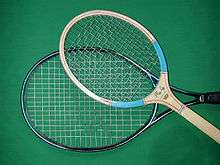Sports engineering
Sports engineering is a fast growing field of engineering which encompasses the design and production of sports equipment and facilities, performance measurement and athletic feedback systems, and the study of kinematics, dynamics and biomechanics as they pertain to sport. The field overlaps other fields of science and engineering, including physics, mechanical engineering, electrical engineering, and materials science, and many practitioners hold degrees in those fields rather than in sports engineering specifically. While sports engineering is not a well known field among pre-college students, professional societies are working to change that.[1][2] Study programs in sports engineering and technology at either the undergraduate or graduate level are now offered at a number of universities.

A sports engineering congress is biannually held, hosted by the International Sports Engineering Association, termed 'The Engineering of Sport'. This conference brings world leading researchers, sports professionals and industry organizations together to celebrate the profession, showcasing new innovations in both research, and industry. The next congress will be hosted in March 26–29 in Brisbane, Australia.[3]
Study programs in sports engineering
- Loughborough University (UK)[4]
- Strathclyde University (Scotland)
- Centre for Sports Engineering Research (CSER) - Sheffield Hallam University (UK)[5]
- TU Delft (Netherlands)[6]
- Griffith University (Australia)[7]
- University of Adelaide (Australia)[8]
- TU Chemnitz (Germany) (undergraduate)[9]
- TU Chemnitz (Germany) (graduate)[10]
- University of Otago (New Zealand)[11]
- Aalborg University (Denmark)[12]
- Private University of Applied Sciences (Germany)[13]
- Mittuniversitetet (Sweden)[14]
- Deutsche Sporthochschule Köln (Germany)[15]
- University of Applied Sciences Technikum Wien (Austria)(undergraduate)[16]
- University of Applied Sciences Technikum Wien (Austria)(graduate)[17]
- Islamic Azad University, Science and Research Branch (Iran) (undergraduate & postgraduate student)
- University of Magedeburg (Germany) https://www.uni-magdeburg.de/Studieninteressierte/Studiengänge+von+A+bis+Z/Bachelor/Sport+und+Technik.print
Scientific journals
- Sports Engineering, ISSN 1369-7072, by Springer
- Proceedings of the Institution of Mechanical Engineers, Part P: Journal of Sports Engineering and Technology, ISSN 1754-3371, by SAGE Publishing
See also
- Sports medicine
- Sports science
- Biomechanics
- Physics
- Mechanical engineering
- Sports technology
References
- "International Sports Engineering Association". International Sports Engineering Association. Retrieved 2017-04-28.
- Celeste Baine (2004), High Tech Hot Shots: Careers in Sports Engineering, National Society of Professional Engineers, ISBN 9780915409235
- "The Engineering of Sport". ISEA.
- "School of Sport, Exercise and Health Sciences | Loughborough University". www.lboro.ac.uk. Retrieved 2017-04-28.
- "Centre for Sports Engineering Research | Sheffield Hallam University". www.shu.ac.uk. Retrieved 2017-04-28.
- "TU Delft Sports Engineering Institute | Sports Engineering Institute TU Delft - Home". sportsengineering.tudelft.nl. Retrieved 2017-04-28.
- "Sport and Biomedical Program". www.griffith.edu.au. Retrieved 2017-04-28.
- "Bachelor of Engineering (Honours)(Mechanical and Sports)". www.adelaide.edu.au. Retrieved 2018-04-06.
- IUZ, Admin. "Bachelor degree program in Sports Engineering | Degree Programs | Incoming | International Office | TU Chemnitz". www.tu-chemnitz.de. Retrieved 2017-04-28.
- IUZ, Admin. "Master degree program in Sports Engineering | Degree Programs | Incoming | International Office | TU Chemnitz". www.tu-chemnitz.de. Retrieved 2017-04-28.
- "Study Sports Technology". www.otago.ac.nz. Retrieved 2017-04-28.
- "Sports Technology". www.en.aau.dk. Retrieved 2017-04-28.
- "Sports Engineering / Rehab Engineering Master's Degree". www.pfh-university.com. Retrieved 2017-04-28.
- "Sportteknologi – maskiningenjör inom innovativ produktutveckling". www.miun.se (in Swedish). Retrieved 2017-04-28.
- Köln, Deutsche Sporthochschule. "M.Sc. Human Technology in Sports and Medicine: Studienaufbau und -inhalte - Deutsche Sporthochschule Köln". www.dshs-koeln.de (in German). Retrieved 2017-04-28.
- "Fachhochschule Technikum Wien". www.technikum-wien.at. Retrieved 2017-05-29.
- "Fachhochschule Technikum Wien". www.technikum-wien.at. Retrieved 2017-05-29.